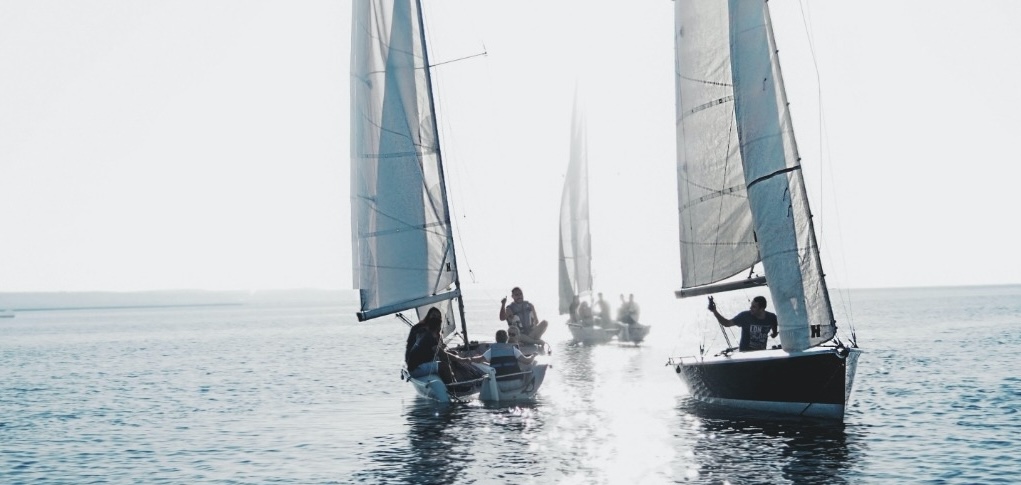SailZoo Blog
Should the boat go ashore or stay in the water over winter?
Fall is creeping into Denmark and many of us are weighing up the pros and cons of whether to leave the boat in the water or take it ashore for the winter. whether to leave the boat in the water or take it ashore for the winter. We've therefore taken a closer look at the pros and cons of storing your boat for the winter.

The boat is stored on land
Benefits:
There are a number of obvious advantages to taking the boat ashore in winter. The most important benefit I would point to is the good night's sleep ;)
- In the event of a hard ice winter, you don't have to worry about your boat sinking in the water due to frost cracking, but when the weather turns to thaw, the water is free to run into the boat and you have to inspect the boat for frost cracking. This problem is completely avoided when the boat is on land.
- Another good reason to take your boat ashore is winter storms. Gusty winds in themselves are not really a problem if the boat is properly moored. However, winter storms can cause extreme high or low tides, which requires you to adjust your moorings and make sure your boat is properly protected by fenders if it's alongside the quay. Of course, if you're on a floating bridge you won't have this problem, but fenders can pop up between your boat and the bridge, so it still requires supervision.
- The ability to store the boat in a heated hall over the winter. No worries about moisture in the boat and you can leave cushions and other things that shouldn't get moldy in the boat. It also won't get dirty and green algae won't grow on the deck. It's also more comfortable to carry out servicing and small repairs, as well as preparing the boat during the winter.

Det er en del mere behageligt at inspicere båden, når den er på land....
Disadvantages:
- Not all ports allow the boat to be landed while the mast remains on the boat, and most damage to the standing rigging occurs when the mast is removed or attached. If you're not experienced in taking the mast off the boat yourself, or have an experienced sailing friend who can help, then contact a rigger and get professional help to take the standing rigging off the boat.
- You also need to take into account the cost of using a crane truck or port facilities for boat lifting.
- The cost of a sturdy boat rack if it is not included in the harbor fees for your mooring.
- If you wait until after the fall break to book a boat launch, you may risk rain and wind at the time you have scheduled the launch.
- When the boat goes back in the water in April and it needs to be bottom painted just before the scheduled launch time, you can also risk cold temperatures, hail or even snow showers.
- If you choose a boat transportation to move the boat to a storage location away from the port, you also need to consider the costs for this.
- Danish winters have become quite mild compared to previous decades, so there can be a number of good days when you would have liked to be out sailing during the winter season. The same goes for spring, when there can also be some good sailing days before the boat has been put back in the water.
The boat stays in the water in winter
Let's look at the pros and cons of leaving your boat in the water all year round.
If the harbor is approved as a so-called A-harbor by the insurance companies' trade association, you can leave your boat over the winter. But for the sake of good order, you should contact your boat insurance if you are not 100% sure what your insurance covers. Some insurance policies cover regardless of whether it's an A or B port.
Benefits:
- One obvious advantage is the ability to save the cost of taking the boat ashore in the fall and launching it again in the spring, as well as the cost of a boat rack. Alternatively, you can choose to lift the boat out of the water on a summer weekend, remove algae and barnacles, give it a fresh coat of bottom paint, and then put it back in the water the same weekend. However, some people choose to extend the maintenance interval and only take the boat ashore every other season. This requires the courage to swim around the boat with a floor scrubber and brush off the algae during the summer 😉
- By leaving your boat in the water all year round, you have the opportunity to take a trip during the winter and enjoy the beautiful winter days on the water. If your boat is in a cozy place where you want to spend time on board during the winter, you can consider installing string lights on the boat for coziness and also find the right heating system for your boat. That way, it can become a home for many cozy moments during the winter."
- During the winter months there is plenty of space in harbors and you will most likely be able to find a good place for your boat over the winter. If you won't be using your boat during the winter, contact a canopy or sailmaker and look into the possibility of a "tailor-made" winter cover for your boat.
Disadvantages:
- There are several risks to consider when leaving your boat in the water during the winter months. These include the risk of frost cracks in the engine, in heating installations and not least in the sea valves and their hoses.
- You should pay attention to your boat's moorings as winter storms can cause extra wear and tear on them. Extreme high or low tides can also cause problems and damage unless the boat is moored at a floating bridge.
- You have to deal with moisture and ventilation in the boat. Cushions, duvets, etc. risk becoming moldy during the winter if there is no proper ventilation or drying out of the indoor climate on the boat.
- Maintenance and small repairs are more difficult to carry out when the boat is in the water during winter.
- Electrical corrosion - when your boat is in the water all year round, and especially during the damp winter months, your electrical systems are much more exposed to the humid marine environment, leading to faster corrosion on your boat, electrical installation and engine.
- Winter is extremely hard on your sprayhood, canopy, lazyjack and sails. So mold and mildew can quickly grow on your fabric parts on the outside of the boat, causing them to deteriorate faster. It's therefore a good idea to have a spare set of the above items, which may be older and can therefore be mounted on the boat for winter use.
- Many ports have closed port facilities during winter, such as access to water, which can be quite annoying when you want to use your boat.
Whatever you choose, it's important to consider how best to maintain the value and condition of your boat. It can therefore be useful to consult other local boat owners or boatyards to gain insight into what works best in your area. Ultimately, the decision to take the boat on land or leave it in the water depends on your personal preferences, budget and how safe you want to sleep when/if "King Winter" takes hold.
Ps: Yours truly leaves the boat in the water and takes the boat on land every 2nd season - this has worked without problems so far.
Ps: Yours truly leaves the boat in the water and takes the boat on land every 2nd season - this has worked without problems so far.
Written by Mads SailZoo day 10. October 2023

Sign up for newsletter
Stay tuned for new sailing articles, sailing industry news and early access to new features.
Also see








.png/)


.png/)




.png/)

.webp/)
.jpg/)
